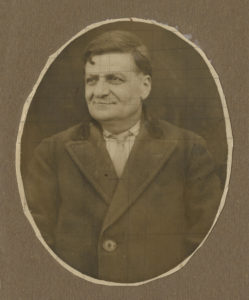Matthew Karanian was about eight years old when he asked for his first camera—a vintage Brownie from his father. “Back then, we were using film,” he recalled one afternoon during a visit to the Hairenik Building in Watertown, Massachusetts ahead of a book presentation with the National Association for Armenian Studies and Research (NAASR). “So my dad would supervise me and make sure I didn’t take too many pictures because it was expensive to process the film.”
A descendant of Armenian Genocide survivors, Karanian has been capturing images ever since. His latest publication—The Armenian Highland: Western Armenia and the First Armenian Republic of 1918—is a stunning tribute to his grandparents who were all deported from their homes in Western Armenia in 1915. His maternal grandmother Houstian, for instance, died just before Karanian was born. “She would tell my mom, ‘I wish I could be a bird and just fly over my house in Zara. I just want to see my house one last time. I want to see if it’s still there,’” said Karanian, reflecting on the emotional survival stories he learned from his mother.
These unfinished stories about all the survivors and martyrs who never had a chance to say goodbye are what compelled Karanian to embark on this 21-year journey—a daunting attempt at filling in those critical missing pieces. He started in Van. “It was my thought that I would find the home of my grandfather. It was quite ignorant of me and naive of me to think that I could find it, because I didn’t understand that Van had been wiped out and leveled in 1918. There was nothing left of it,” said Karanian pointing to a two-page wide shot of green pastures dotted with sheep, a shepherd keeping watch and a stream running through.

Dramatic differences like these are what Karanian aimed to feature throughout this historical resource. Inspired by the ancient and legendary cartography of his great uncle Mardiros Kheranian and armed with the richly detailed and generously donated maps of the late Professor Robert Hewsen, who died just before the Armenian Highland was published, Karanian set out on a challenging task in 1997 to locate what’s left of the grand Armenian monasteries and sacred sites from over a century ago. Hewsen’s work also inspired Karanian on the title of the Armenian Highland. He says it’s a vast geographic term that we can all agree on, one that was used for three thousand years until about 1940. Karanian says he is resurrecting the name as a way of revitalizing the concept of one nation by avoiding the regional divisions of Western and Eastern.
Karanian’s work resulted in a 312-page curated, informative and useful guide for travelers and historians packed with 250 maps and photographs from a variety of sources including the Library of Congress, the Armenian Revolutionary Federation (ARF) archives and of course, his own personal, original collection of images from his extensive travels. The text even includes GPS coordinates for avid explorers eager to witness these sights for themselves. “It’s an overarching view of our homeland,” explained Karanian, “but it’s also got minute detail and stories.”
In the Kurdish village of Chengelli, for example, Karanian discovers pieces of Soorp Garabed in the most unexpected place. “This was a source of heartbreak—to discover the stones from our churches were treated as quarry material for new homes,” he said while pointing to uniquely carved khatchkars adorning the stone wall of a humble village home. “This is our homeland, and it’s being dismantled,” he said. However, the builders, he explained, were not malicious, but rather resourceful, repurposing stones from a nearby monastery that nobody had used for over a century.
Karanian also described his interactions with some of the inhabitants of these villages. Some told Karanian that they wanted to restore the church and make it a tourist attraction to generate income. In other towns, he said, children would run to him and his travel companions and lead them to the “Armenian rocks.” Karanian says these locals lack the historical understanding in appreciating the value of these priceless and ancient artifacts. “Let’s bring them out of their ignorance. Let me surprise them and show them that there is a human face attached to these stones, and that these stones that they’re using as quarry material are the stones of my grandparents and your grandparents.”
That ignorance doesn’t just apply to the villagers in these stolen territories. Karanian says it’s also important for Armenians to educate themselves about the rest of the Armenian Highland that is not under our control. “If we are going to maintain our history in that part of the world, we need to know what that history is,” he explained. “We can’t save our churches if we don’t know where they’re located.”
As for Karanian, he tells the Armenian Weekly he wants to research Cilicia, which was not included in the Armenian Highland. “It’s a work that’s continuing,” he said.



Matthew has made lasting contributions to our nation with his research and publications. His latest book….”The Armenians Highlands……” should be in every home as an educational tool for adults and their children. “We can’t save our churches if we don’t know where they are located”. Great comment….everything starts with knowledge.
Wasn’t able to order Karanian’s latest book. I DO NOT HAVE and DO NOT WANT to pay by Pen Pal. Very frustrating. Don’t you take other credit cards?
Hi Margaret, thank you for your interest in The Armenian Highland. The publisher’s website http://www.HistoricArmeniaBook.com accepts all major credit cards. The merchant that processes the credit cards is Pay Pal. But you do not need a Pay Pal account. All you need is a major credit card such as Visa or MasterCard.
I have Matthew Karanian’s book, Historic Armenia – After 100 Years. It is a beautiful book and highly recommend having it in your library. I visited several of the spots he photographed. I am looking forward to owning “The Armenian Highlands”, A touchstone to the past. We are fortunate to have Matthew and thank him for his dedication.